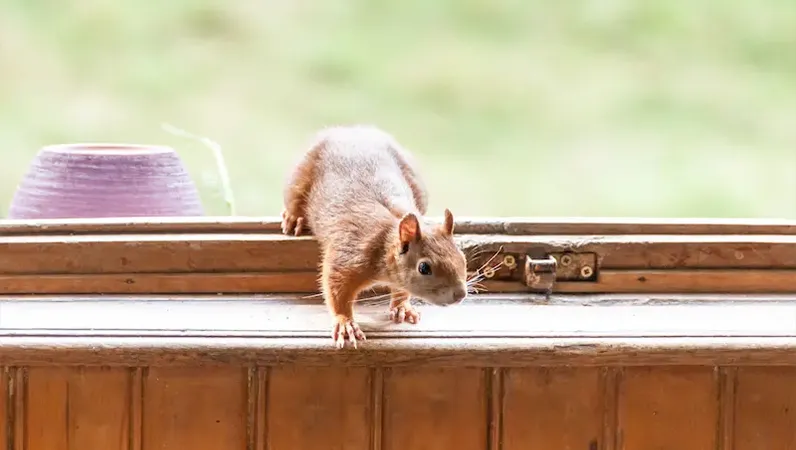You slide into bed, pull the blankets tight, and turn off the lights expecting a calm night and then you hear something scratching from within the wall. The unexpected noise sparks worry and makes it clear that you must find the cause. If pests are behind the sound, reaching out to an exterminator immediately is crucial.
If your bedroom does not feel safe anymore, Xceptional Wildlife Removal has experts ready to eliminate the problem and restore your peaceful sleep.
What is Causing Scratching Noises in My Walls?
If you’re hearing scratching, scurrying, or other unusual noises coming from your walls at night, it’s likely that unwanted pests have made your home their own. These pests could include rodents such as mice, rats, or squirrels, or even larger animals like raccoons or bats. They often seek out dark, warm, and protected spaces inside your walls to build nests and raise their young. Ignoring these sounds can allow the problem to grow and cause damage to your home.
Do I Have Pests Inside My Walls?
It is very common for pests, whether insects or rodents, to take shelter in the dark, enclosed spaces of your home, especially during seasonal changes or breeding periods. You might hear squeaking, scratching, or chirping noises, and if they remain inside the walls long enough, you could notice odors from urine, feces, or even decomposition. Ignoring these signs can lead to structural damage and potential health risks for your family.
What Types of Pests Live Inside Walls?
Many pests can find their way into the walls of your home, and they rarely come alone. Here are some of the most common culprits that might be making noises behind your walls:
- Rodents: Rats and mice are the most common cause of scratching and scurrying sounds in walls, often moving in large numbers.
- Squirrels: Squirrels may chew and claw at walls as they search for nesting spots, especially in attics and upper walls.
- Raccoons: Raccoons can create loud noises while climbing and moving inside walls, particularly at night when they are most active.
- Bats: Bats often roost in wall cavities or attics, creating fluttering and scratching noises.
- Termites and Carpenter Ants: These insects can gnaw on wood inside walls, producing faint scratching or clicking sounds over time.
Is it Possible For Rats to Chew Through Walls?
Yes, a variety of pests, including rats, can chew through walls. Mice, rats, squirrels, and raccoons can chew through wood, drywall, plaster, and other building materials, and their chewing can weaken the structure of your home. Once inside, they live, leave waste, breed, and die, creating health hazards for humans and pets, and rats and mice often chew on electrical wires, which can create a serious fire risk.
How Long Can a Squirrel Survive Inside a Wall?
A squirrel trapped in a wall can survive for several days depending on the conditions inside. Without food and water, it may only survive a couple of days, but if it has access to crumbs or moisture, it could last longer. During this time, it may make constant scratching or gnawing noises as it searches for a way out. It can also leave droppings or chew on insulation, causing damage to the wall.
How Long Can Rats Live Without Food?
In general, a rat can survive for up to two weeks without food as long as it has access to water. Rats are resilient and can endure harsh conditions for longer than most people expect. Their ability to adapt to different environments makes them persistent pests in homes. Factors like size, age, and overall health can influence how long a rat survives without food.
How Can I Remove Pests From My Walls?
Mice and rats can sometimes be coaxed out of walls using food-baited traps. Larger animals often require cutting a section of drywall and using a catchpole to safely remove them, which is why professional wildlife removal is recommended, since these creatures can become aggressive if disturbed.
Raccoons are especially dangerous to handle on your own, and bats are equally tricky to remove. Professionals typically use nets and carefully cut openings in walls to capture these animals safely. Once all pests are gone, it is essential to locate and seal their entry points to prevent them from returning.
How to Get a Squirrel Out of Your Wall
If you hear scratching or movement in your walls, a squirrel may have taken up residence. Removing it safely requires careful steps to avoid harming the animal or causing damage to your home. Here are some effective steps to get a squirrel out of your wall:
- Identify Entry Points: Locate the squirrel’s main entry point and check for any other potential access points that need to be sealed.
- Install a One-Way Door: Set up a one-way exclusion door at the entry point so the squirrel can exit but cannot return.
- Use Humane Traps: If the one-way door does not work, place humane traps baited with food to safely capture the squirrel.
- Seal and Secure: After the squirrel is removed, permanently seal the entry point and any other openings to prevent future infestations.
Dealing with a squirrel in your wall can be challenging, so enlisting a wildlife removal expert is often the best option.
Protect Your Walls and Home with Xceptional Wildlife Removal
Xceptional Wildlife Removal has been eliminating pests, including those that take up residence in your walls, for more than [years] years. Our trained wildlife experts in Virginia remove unwanted animals and ensure your home is protected. We also offer year-round protection plans to prevent future infestations. By addressing the problem early, we help homeowners avoid costly repairs and maintain a safer living environment.
Call Xceptional Wildlife Removal immediately at the first sign of trouble for a no-cost service estimate.

